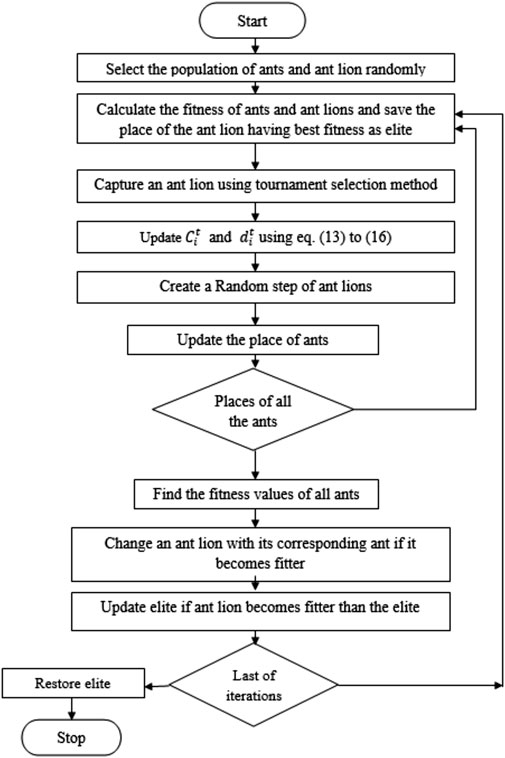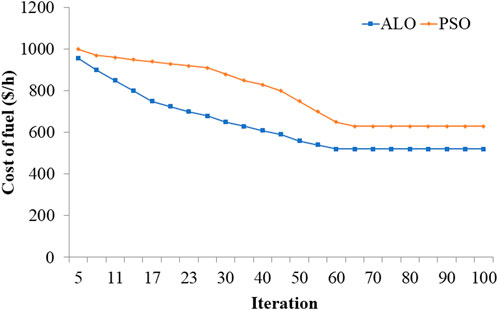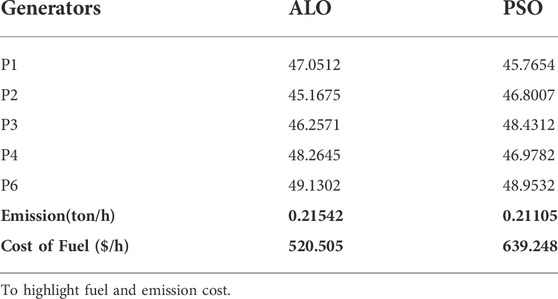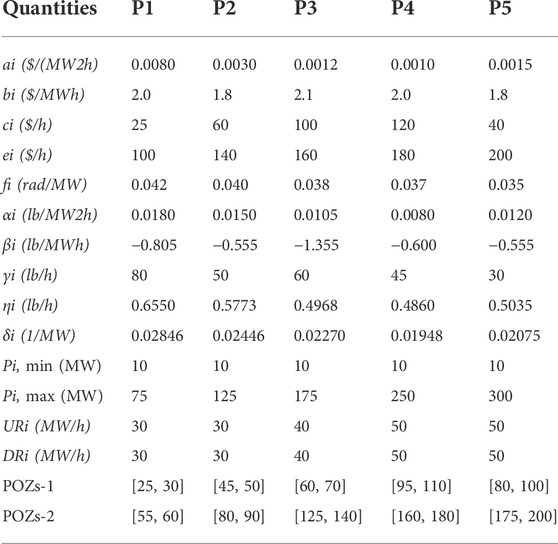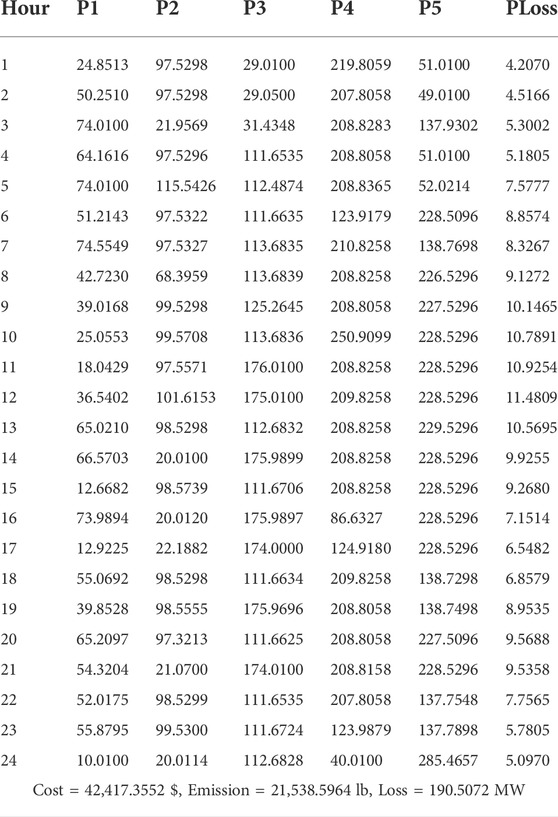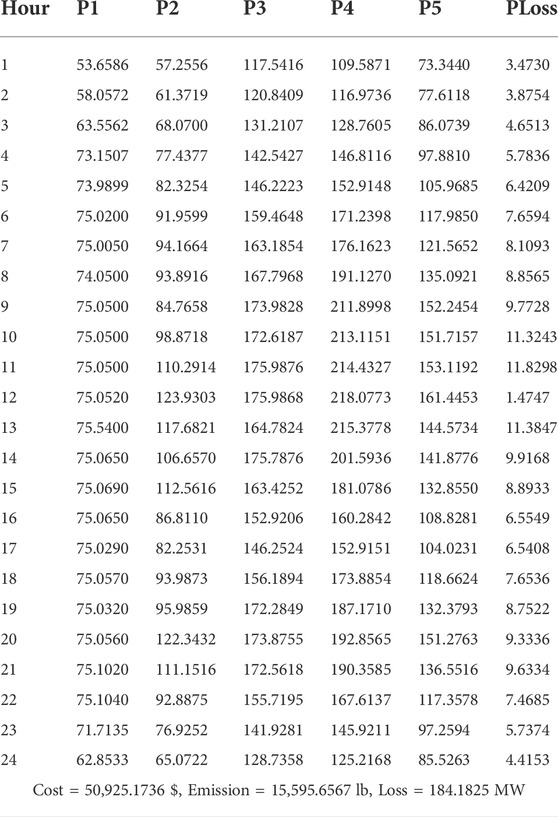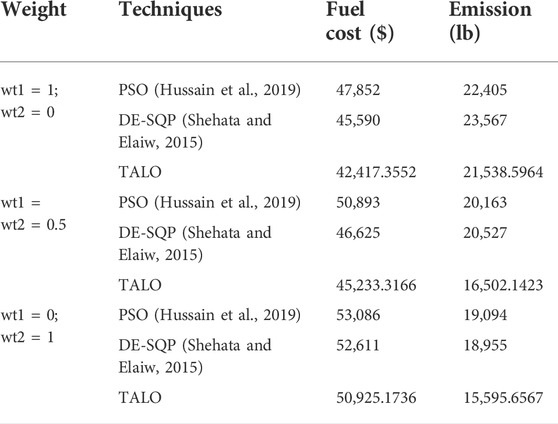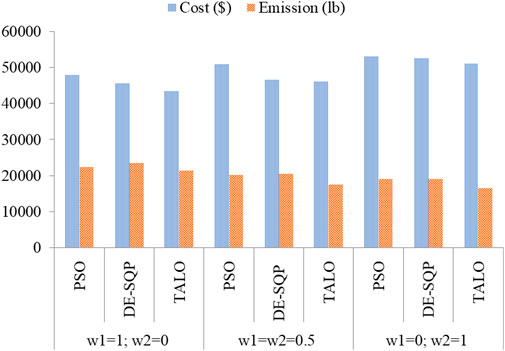- 1Department of EEE, Noorul Islam Centre for Higher Education, Kumarakovil, India
- 2Department of Electronics and Communication Engineering, Centurion University of Technology and Management, Jatni, Odisha, India
- 3Centre for Renewable Energy and Environment, Centurion University of Technology and Management, Jatni, Odisha, India
- 4School of Energy and Environment, City University of Hong Kong, Kowloon, Hong Kong SAR, China
- 5School of Electrical Engineering, KIIT University, Bhubaneswar, India
- 6Department of Electrical Engineering, Graphic Era (Deemed to be University), Dehradun, India
- 7Department of Electrical Engineering, National Institute of Technology, Delhi, India
- 8School of Electrical Engineering, Xi’an Jiaotong University, Xi’an, China
- 9Electrical Engineering Department, Faculty of Energy Engineering, Aswan University, Aswan, Egypt
The static and dynamic economic dispatch problems are solved by creating an enhanced version of ant lion optimisation (ALO), namely a tournament selection-based ant lion optimisation (TALO) method. The proposed algorithm is presented to solve the combined economic and emission dispatch (CEED) problem with considering the generator constraints such as ramp rate limits, valvepoint effects, prohibited operating zones and transmission loss. The proposed algorithm’s efficiency was tested using a 5-unit generating system in MATLAB R2021a during a 24-hour time span. When compared to previous optimization methods, the suggested TALO reduces the costs of fuel and pollution by 9.01 and 4.7 percent, respectively. Furthermore, statistical analysis supports the suggested TALO optimization superiority over other methods. It is observed that the renewable energy output can be stabilized in the future by combining a hybrid dynamic economic and emission dispatch model with thermal power units, wind turbines, solar and energy storage devices to achieve the balance between operational costs and pollutant emissions.
1 Introduction
In today’s environment, the most efficient and effective operation of an electric power system is critical. In recent years, all utilities have become increasingly reliant on operating their systems at the lowest possible cost while satisfying consumer demand in order to generate income (Basu, 2011). Because of the large growth in demand for the power system, the limited availability of generating systems, and supply and fuel cost constraints, all committed units should provide energy at the lowest possible cost to fulfill demand (Giri and Mohanty, 2020). The energy delivered by committed units is not continuous in Economic Dispatch Problems. It is permitted to generate within specified parameters in order to meet particular demands with the least quantity of fuel possible. The traditional method alone is not possible to deliver energy at low cost. Aside from fuel cost targets, Emission dispatch is a temporary solution that should be maximized. The majority of electricity is generated by fossil fueled thermal power plants which results in environmental pollutants such as CO2, SO2 and NOx. SO2 and other sulfur oxides can contribute to acid rain which can harm sensitive ecosystems. As a result, the combined economic and emission dispatch (CEED) is considered as a multi-objective optimization problem. By taking into consideration diverse objective functions, a variety of traditional and cutting-edge solutions have been used to tackle economic power dispatch challenges (Benasla et al., 2014). Various traditional techniques such as lambda iterative technique, gradient-based technique, Newton-based method, modified group search optimization (MGSO) (Daryani and Zare, 2018), Dynamic economic dispatch problems: PSO approach (Ab Ghani et al., 2017). A new modified artificial bee colony algorithm (Secui, 2015b), particle swarm optimization and genetic algorithm techniques (Hussain et al., 2019), chaotic improved harmony search algorithm Several optimization strategies and procedures have been utilized to solve the dynamic economic dispatch (DED) problem with complex objective functions or constraints since the topic was proposed in the 1980s (Rezaie et al., 2019). Literature survey shows to solve this problem using conventional algorithms (Kamli and Amraee, 2017), Dynamic economic dispatch using hybrid meta heuristics (Santra et al., 2020) and Simulated Annealing method (Bouddou et al., 2020) for non-smooth or non-convex cost functions, the majority of these strategies are ineffective. To solve the DED problem, a variety of heuristic optimization methods have been used, including Ant based optimization (Secui, 2015a; Vennila and Rajesh, 2022), Dragon fly based optimization (Chandrasekaran et al., 2021), Hybrid HB-SA algorithm (Vennila et al., 2013), differential evolution techniques (Li et al., 2022; Zou and Gong, 2022), harmony search algorithm (Rezaie et al., 2019), and bee swarm based optimization algorithm (Hussain et al., 2019). With some limits in the cost function curves, many of these strategies have been proved to be effective in tackling the DED problem. These techniques solve the DED based on a population of individuals, each of whom represents a potential solution (Wang et al., 2016). The original population is then evolved by applying a group of operators to the traditional methods in order to replace them with new ones. Mirjalili recently developed Ant Lion Optimization (ALO), a breakthrough nature-inspired approach (Pan et al., 2022). The ALO approach was used to tackle the CEED problem, which took into account restrictions on ramp rate, Effects of valve points, forbidden transmission loss, operational zones (Song et al., 2015). The effectiveness of the proposed method was demonstrated on a six- and ten-unit generation system, respectively.
In this study, the generator’s power constraints are regarded as a new way for handling static and dynamic CEED problems using Tournament-based ALO methodology. CEED’s purpose is to simultaneously minimise operating fuel costs and emissions while fulfilling power demand and operational limitations. Using a modified weighting factor technique, this multi-objective CEED problem is reduced to a single goal function. TALO is being investigated in order to determine the proper generator loading in power systems. The resilience of TALO is demonstrated using the results of simulations for local and valve loading effect in large-scale power systems. The Tournament based Ant Lion Optimizer (TALO), which is inspired by the way ant lions hunt, is suggested. Five unit test functions are used to benchmark the TALO algorithm.
The manuscript is structured in five sections; Section 2 presents problem formulation. The proposed algorithm for solving the problem is given in Section 3. Results and discussion are provided in Section 4, followed by conclusions in Section 5.
2 Problem formulation
The CEED’s mission challenge is to lower both fuel prices and emissions while maintaining equity and disparity. Because the functions of fuel price and pollution cost are independent of one another, the problem issue is two-objective. Two-objective problems can be solved by combining two objective functions into a single one. The CEED issue is changed into a single-objective function in this work, and a price penalty component is employed to improve the process.
2.1 Economic load dispatch
In order to reduce the overall cost of generation and meet the equality and inequality restrictions, the economic load dispatch is an online mechanism for assigning generation among the available generating units.
To minimise the fuel cost, the below function is considered,
2.2 Equality constraints
2.3 Economic load dispatch with loss
where,
2.4 Capacity limitations
2.5 Valve point loading for cost-effective load dispatch
When the valve is not entirely opened, the impact of the valve point is enormous, and when the valve is fully opened, the impact is minimal (Yang et al., 2021). This behaviour can be mimicked in the characteristic curve by combining a multiple routine sinusoidal curve with a regular quadratic value feature. As a result, the generator devices’ real input-output curves are non-convex. There will also be ripples in the gasoline price curve when the valve begins to establish/final and will burst off when the valve is fully opened. The objective function will become when the valve point-impact is added.
Coefficients of fuel price of ith generator unit are
2.6 Limits on ramp rates
Limitations on ramping up and down can be expressed as:
Where P (i, t) and P (i, t-1) respectively, are the present and previous real power outputs. The ramp-up and ramp-down limits of ith unit are URi and DRi. By considering both ramp rate restrictions and limits on actual power output the equation is:
2.7 Prohibited operating zones
Due to machine component constraints or worries about instability, a limited operation zone may exist for producing units. The generator’s possible operating zones can be defined as follows (Wang et al., 2016; Rezaie et al., 2019):
2.8 Dispatching of emissions
The function of emission dispatch, can be written as
Toxic gases emitted by the energy plant must be transported to the system.
As a result, the mixed emission feature is as follows:
2.9 Combined economic and emission dispatch
The combined economic and emission dispatch (CEED) problem is used to minimise fuel costs and emissions concurrently by adhering to a variety of real-world equality and inequality constraints.
Combined Economic and Emission function is given as.
3 Algorithm for ant lion optimization
3.1 Inspiration
The ALO a set of guidelines, based on a description of the way an ant-lion takes its prey by digging sand pit traps in the sand and trapping it. The pit’s dimension is proportional to the moon’s mild. The ant-lion minimise the size of its pit with the help of its prey (Pan et al., 2022).
3.2 Mathematical model of the ant-lion algorithm
The versioning of random ant walks is the first stage in the set of rules.
X1 (t) = 0; cs1 (2r1 (t_1−1),cs1 (2r1 (t_2−1),….cs1 (2r1 (t_n−1).
The total of all random walks is referred to as ‘cs1.’
The total number of iterations executed is denoted by n'.
r1 (t) is a initial-rate characteristic described and r (t) is the principal feature for the same, and t' portrays an ant’s random and unique step.
Because of the possibility of being stuck by an ant lion, ant fitness is taken into consideration. This health must also be correctly expressed in a matrix.
Ant lions are also thought to be hiding in the area, in addition to ant behaviour. As seen in the picture below, their function becomes still another key requirement.
For better use-case resolution, an ant lion fitness component should be considered. Because of the matrix that represents each ant lion’s fitness functions, MOAL is handled.
Any additional requirement is to maintain the random stroll within the designated location. A mix-max normalisation method is used to test this.
Where,
bi—denotes the highest of the variable I walks.
The smallest of the ith variable at the tth iteration is shown by
Ant lions may construct snare that are commensurate to their objective function levels (instant). They compelled to move in a disorganized level. When the ant lions are attentive that the ants are being held captive, they sling sand from the cone-shaped hole’s centre to the floor, diminishing the ants’ chances of escaping. By gradually decreasing the width of the ants’ search radius, the derivative model of this behavior can be overfed. The following equations are used to compensate.
With ants finishing the middle of the pit and an ant lion seizing it with its jaws, the hunt comes to an end. After this stopping condition, the ant lions drive the ants nearer to the pit’s centre, where they are destroyed. For the purposes of analyzing the whole use case scenario, we’ll assume that after an ant-lion take its prey, it gets much fitter than an ant-lion of that generation. To augment its chances of gathering morel ants, the ant lion was supposed to return to its current site while observing ants. The following equation is presented for the same.
Ant lion tj denotes the position of the jth ant lion at the tth new release, whereas Ant ti denotes the placement of the ith ant lion at the tth new release.
Many algorithms have an elitism feature that allows them to preserve their most favorable output at any point during implementation. The gorgeous ant lion spotted below the new release was reclaimed in the database and is now regarded as a good result. Because the elite ant lion is viewed as the best, it will influence the actions and movements of all ants in succeeding cycles. This assumes that the chosen ant lion ringed every ant walk at random.
Where
3.3 Tournament selection based ant lion optimization algorithm
The ALO algorithms haphazardly walk model, mechanism of hunting, selection technique, and other features were updated in this study. The random walking mechanism in the earliest ALO program generates the ant’s shambling route using the iteration count maximum. In terms of the algorithm’s execution time, this method is ineffective. As a result, by lowering the size of the random walk, the first ALO algorithm breakthrough was achieved. It was chosen as the number of iterations that can be done in a given amount of time. As a result, the ALO algorithm’s long running time has been significantly reduced. During the stage of sliding ants towards the ant lion’s trap, a certain rate of slippage is used to shift the ants toward the ant lion’s trap. We were able to improve the ants’ movement by adding sand to the ant lion’s pit. The following formulae are used to calculate it.
Where
Where rand1 represents a random number between (Ab Ghani et al., 2017) blow indicates the lower bound and bup is the upper bound of the search location. The selection approach is used by meta-heuristic algorithms to pick better people from a group. Roulette wheel, tournament, truncation, linear ranking, and selection based on exponential ranking are only a few examples. The most effective way for overcoming reduction concerns is tournament selection. This method involves holding a tournament among people chosen at random, with the tournament champion being the person with best cost-benefit ratio. The tournament size, often called the tour, is an important part of this technique. Only two people were allowed to join the excursion. The tournament method divides the population into two groups at random, with the size of each group determined by dividing the population by the tournament size, as given in Figure 1.
4 Results and discussion
4.1 Five generator test systems with ant lion optimizer
To provide the findings, the unit with ALO was completed with the same old quantities and general demand as 2.83 p.u. The results, which included generation value and pollution cost, were well-optimized, with excellent convergence characteristics. These are listed in the table below.
The simulation results received from the ALO for the best solution to the power demand of 2.83 p.u are shown in Table 1, which shows the simulation results acquired from the ALO for the best solution to the power demand of 2.83 p.u and the convergence characteristics are shown in Figure 2. Table 1 compares ALO and various optimization algorithms when compared to existing population-based optimization techniques in the literature, the suggested algorithm performs the best.
The recommended approach’s effectiveness is demonstrated using a 5-unit generation system with rugged fuel cost and emission functions. The need for the system has been distributed into 24 intervals, ranging from 414 to 751.47 MW, with a total of 468.0899 MW. Transmission losses are calculated using the B-loss coefficients formula. The simulation parameters are as follows: Maximum generation is 100, and the population size is 40. Table 2 shows the selected data of the 5 unit system and Tables 3, 4, 5 show the optimum solutions for dynamic economic dispatch (DED), dynamic economic emission dispatches (DEED), and pure dynamic emission dispatch (PDED), respectively.
The hourly generation time, cost, and emission obtained from the DED issue are shown in Table 3. The generating schedule is updated every hour. The cost, and emission obtained from the PDED problem are shown in Table 5. Tables 3, 5 show that the cost of DED is 42,417.3552 $, but that it rises to 509,251.1736 $ under PDED, and that the emission derived from DED is 21,538.5964 lb, but that it drops to 15,595.6567 lb under PDED. Table 4 displays the DEED problem’s hourly generation schedule, cost, and emission. It can be observed that the cost is 45,233.3166 dollars, which is more than 42,417.3552 dollars but lower than 50,925.1736 dollars and the emission is 16,502.1423 pounds, which is lower than 21,538.5964 pounds but higher than 15,595.6567 pounds.
Table 6 compares the effectiveness of the suggested solution to alternative approach for the DEED problem with various weighting factors. Both the fuel price and the emission cost are lower than other mechanism published in the article. The graphical representation of various optimisations techniques is shown in Figure 3.
5 Conclusion
This work describes the tournament selection-based ALO algorithm (TALO), which was used to solve a static and dynamic combined economic and emission dispatch (CEED) problem using MATLAB R2021a. The simulation results received from the ALO for the best solution of static economic and emission dispatch problem to the power demand of 2.83 p.u is obtained. The TALO algorithm was compared to the PSO and DE-SQP algorithms. The comparison reveals that the suggested TALO method may compete in terms of performance with meta-heuristic algorithms. The proposed TALO method outperforms the original ALO algorithm on all metrics. When the suggested TALO algorithm adjustments are compared to alternative optimization methodologies, the outcome clearly show that the proposed TALO algorithm clearly outperforms the competition. The significant findings are:
1) The generation cost for dynamic economic and emission dispatch problems was reduced by 18.51 percent utilizing TALO, and the emission of harmful pollutants into the atmosphere was reduced by 1.8 percent.
2) Among the two methods discussed in the literature, the method that was suggested had the least gap in Economic and Emission values, indicating that it produces a better-compromised solution than the other two. Because the suggested TALO reduces the generating cost and the amount of emitted pollutants by 9.01 percent and 4.7 percent, respectively.
This research based on the economic and emission dispatch approach can be extended by solving large dynamic and multimodal test systems including renewable energy. The combined economic and emission dispatch problem with wind power penetration also aims to achieve optimal scheduling of power generators to minimize the fuel cost and emission generated by thermal generators while simultaneously satisfying all the equality and inequality constraints so that wind energy becomes a part of energy mix and supplies a portion of the power demand. Renewable energy power generation technology has an important impact on reducing pollutant emissions and promoting sustainable development.
Data availability statement
The original contributions presented in the study are included in the article/supplementary material, further inquiries can be directed to the corresponding author.
Author contributions
HV: Conceptualisation, Methodology, Formal analysis, Writing–Original Draft; NC: Conceptualisation, Data Curation, Writing–Original Draft; NM: Validation, Resources, Writing–Review and Editing, Visualization; PS: Supervision; MB: Validation, Writing–Review and Editing; MA: Supervision; SK: Funding acquisition. All authors reviewed the results and approved the final version of the manuscript.
Acknowledgments
HV and NG acknowledges the support extended by Noorul Islam Centre for Higher Education, Tamil Nadu, India and Centurion University of Technology and Management, Odisha, India.
Conflict of interest
The authors declare that the research was conducted in the absence of any commercial or financial relationships that could be construed as a potential conflict of interest.
Publisher’s note
All claims expressed in this article are solely those of the authors and do not necessarily represent those of their affiliated organizations, or those of the publisher, the editors and the reviewers. Any product that may be evaluated in this article, or claim that may be made by its manufacturer, is not guaranteed or endorsed by the publisher.
References
Ab Ghani, M. R., Hussein, S. T., Amin, N. H. M., Jano, Z., and Sutikno, T. (2017). Dynamic economic dispatch problems: PSO approach. TELKOMNIKA Telecommun. Comput. Electron. Control) 15 (1), 48. doi:10.12928/telkomnika.v15i1.4618
Assiri, A. S., Hussien, A. G., and Amin, M. (2020). Ant lion optimization: Variants, hybrids, and applications. IEEE Access 8, 77746–77764. doi:10.1109/access.2020.2990338
Basu, M. (2011). Artificial immune system for dynamic economic dispatch. Int. J. Electr. Power & Energy Syst. 33 (1), 131–136. doi:10.1016/j.ijepes.2010.06.019
Benasla, L., Belmadani, A., and Rahli, M. (2014). Spiral optimization algorithm for solving combined economic and emission dispatch. Int. J. Electr. Power & Energy Syst. 62, 163–174. doi:10.1016/j.ijepes.2014.04.037
Bouddou, R., Benhamida, F., Zine, I., Zeggai, A., and Belgacem, M. (2020). Solving bid-based dynamic economic dispatch in competitive electricity market using improved simulated annealing algorithm. Math. Problems Eng. 07 (04), 621–630. doi:10.18280/mmep.070415
Chandrasekaran, G., Karthikeyan, P. R., Kumar, N. S., and Kumarasamy, V. (2021). Test scheduling of system-on-chip using dragonfly and ant lion optimization algorithms. J. Intelligent Fuzzy Syst. 40 (3), 4905–4917. doi:10.3233/jifs-201691
Daryani, N., and Zare, K. (2018). Multiobjective power and emission dispatch using modified group search optimization method. Ain Shams Eng. J. 9 (3), 319–328. doi:10.1016/j.asej.2016.03.001
Giri, N. C., and Mohanty, R. C. (2020). Performance evaluation of one MW on-grid SPV power generation plant in odisha, India. Indian J. Nat. Sci. 10 (58), 18084–18091.
Hussain, S., Al-Hitmi, M., Khaliq, S., Hussain, A., and Asghar Saqib, M. (2019). Implementation and comparison of particle swarm optimization and genetic algorithm techniques in combined economic emission dispatch of an independent power plant. Energies 12, 2037. doi:10.3390/en12112037
Kamli, S., and Amraee, T. (2017). Blackout prediction in interconnected electric energy systems considering generation re-dispatch and energy curtailment. Appl. Energy 187, 50–61. doi:10.1016/j.apenergy.2016.11.040
Li, L. L., Lou, J. L., Tseng, M. L., Lim, M. K., and Tan, R. R. (2022). A hybrid dynamic economic environmental dispatch model for balancing operating costs and pollutant emissions in renewable energy: A novel improved mayfly algorithm. Expert Syst. Appl. 203, 117411. doi:10.1016/j.eswa.2022.117411
Pan, S., Jian, J., and Yang, L. (2022). Solution to dynamic economic dispatch with prohibited operating zones via MILP. Math. Biosci. Eng. 19 (7), 6455–6468. doi:10.3934/mbe.2022303
Rezaie, H., Kazemi-Rahbar, M. H., Vahidi, B., and Rastegar, H. (2019). Solution of combined economic and emission dispatch problem using a novel chaotic improved harmony search algorithm. J. Comput. Des. Eng. 6 (3), 447–467. doi:10.1016/j.jcde.2018.08.001
Santra, D., Mukherjee, A., Sarker, K., and Mondal, S. (2020). Dynamic economic dispatch using hybrid metaheuristics. J. Electr. Syst. Inf. Technol. 7 (3). doi:10.1186/s43067-020-0011-2
Secui, D. (2015). A method based on the ant colony optimization algorithm for dynamic economic dispatch with valve point effects. Int. Trans. Electr. Energy Syst. 25 (2), 262–287. doi:10.1002/etep.1841
Secui, D. C. (2015). A new modified artificial bee colony algorithm for the economic dispatch problem. Energy Convers. Manag. 89, 43–62. doi:10.1016/j.enconman.2014.09.034
Shehata, M., and Elaiw, A. M. (2015). Hybrid DE-SQP for solving dynamic economic emission dispatch with prohibited operating zones. Int. j. sci. eng. Res. 6 (10), 1136–1141.
Song, H. M., Sulaiman, M. H., and Mohamed, M. R. (2015). An application of flower pollination algorithm to solve combined economic emission dispatch by considering valve-point loading effect. Int. Rev. Model. Simulations 8 (4), 427. doi:10.15866/iremos.v8i4.6182
Vennila, H., and Rajesh, R. (2022). Chapter 46, ant lion optimization for solving combined economic and emission dispatch problems. Springer Science and Business Media LLC.
Vennila, H., Ruban Deva Prakash, T., and Rajesh, R. (2013). A solution to the combined economic and emission dispatch using Hybrid HB-SA algorithm on Large scale power system. Int. Rev. Model. Simulations 6 (4), 1256–1263.
Wang, G. G., Gandomi, A. H., Zhao, X., and Eric Chu, H. C. (2016). Hybridizing harmony search algorithm with cuckoo search for global numerical optimization. Soft Comput. 20 (1), 273–285. doi:10.1007/s00500-014-1502-7
Yang, W., Peng, Z., Yang, Z., Guo, Y., and Chenc, X. (2021). An enhanced exploratory whale optimization algorithm for dynamic economic dispatch. Energy Rep. 7, 7015–7029. doi:10.1016/j.egyr.2021.10.067
Keywords: ant lion optimizer, tournament selection ant lion optimization, combined static and dynamic economic emission dispatch, valve point loading, optimization
Citation: Vennila H, Giri NC, Nallapaneni MK, Sinha P, Bajaj M, Abou Houran M and Kamel S (2022) Static and dynamic environmental economic dispatch using tournament selection based ant lion optimization algorithm. Front. Energy Res. 10:972069. doi: 10.3389/fenrg.2022.972069
Received: 17 June 2022; Accepted: 30 June 2022;
Published: 07 September 2022.
Edited by:
Sudhakar Babu Thanikanti, Chaitanya Bharathi Institute of Technology, IndiaCopyright © 2022 Vennila, Giri, Nallapaneni, Sinha, Bajaj, Abou Houran and Kamel. This is an open-access article distributed under the terms of the Creative Commons Attribution License (CC BY). The use, distribution or reproduction in other forums is permitted, provided the original author(s) and the copyright owner(s) are credited and that the original publication in this journal is cited, in accordance with accepted academic practice. No use, distribution or reproduction is permitted which does not comply with these terms.
*Correspondence: Salah Kamel, c2thbWVsQGFzd3UuZWR1LmVn
 H. Vennila
H. Vennila Nimay Chandra Giri
Nimay Chandra Giri Manoj Kumar Nallapaneni
Manoj Kumar Nallapaneni Pampa Sinha
Pampa Sinha Mohit Bajaj
Mohit Bajaj Mohamad Abou Houran
Mohamad Abou Houran Salah Kamel
Salah Kamel